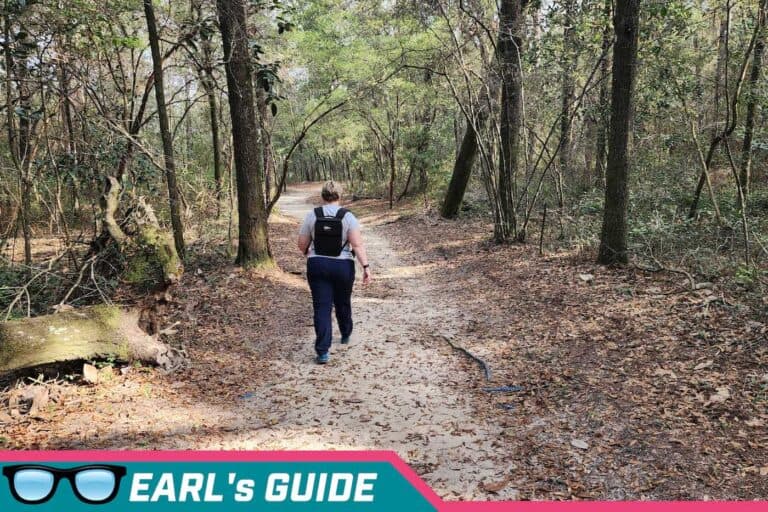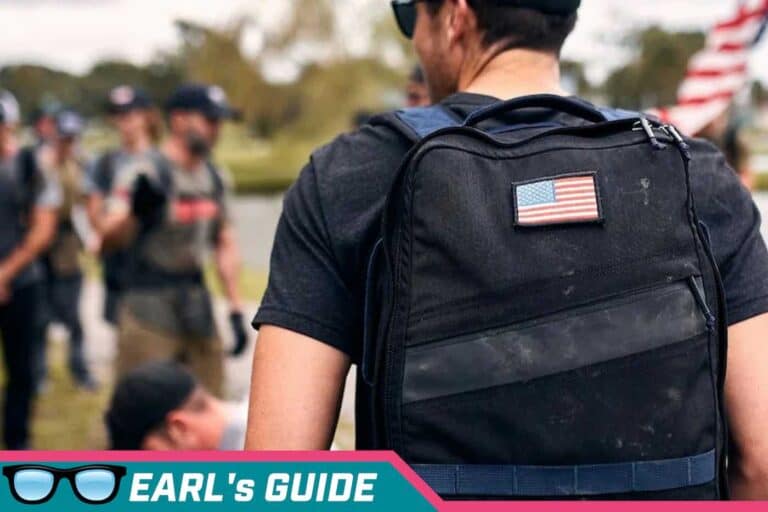When we started full-time RVing, we had concerns about how we were going to stay physically fit on the road. My wife and I had previously belonged to CrossFit gyms, but we knew that we would not be able to carry the amount of traditional RV fitness equipment needed to perform a CrossFit workout of the day (WOD).
As we researched further, we also saw that the cost to drop into a CrossFit box at each location we visited would be cost-prohibitive. And we needed a more comprehensive workout than we could get in a 24-hour fitness or anytime fitness environment.
That is why we explored Rucking.
Rucking Explained
Have you ever heard of rucking? It’s the perfect activity to keep your fitness levels up while on the road. Rucking is a simple concept with a lot of benefits.
It’s basically walking with a weighted backpack and can be done anywhere, anytime.
Whether you’re looking to get in shape, explore the great outdoors, or want an alternative to traditional cardio workouts, rucking is a great option. Rucking combines walking and weight-bearing exercise that adds stress, forcing your body to work harder and get stronger in return. Plus, it can be done anytime, anywhere! And for full-time RVers, it’s a great way to stay active while on the road.
With rucking as part of your routine, you will be able to maintain physical strength and gain mental clarity and self-awareness by being active outdoors. You’ll never miss a workout again!
Read more about how easy it is to incorporate rucking into any journey today!
What is Rucking? – A Detailed Explanation and History
1. Rucking is a form of walking that involves carrying a weighted backpack.
Rucking is a great way to add strength and cardiovascular training to daily workouts. Popularized by ruck marches in military training, rucking involves putting on a weighted backpack and walking for an extended period of time.
The rucksack’s weight helps build up core muscles and engage your arms, legs, and back more than usual during a normal walk. While rucking can be done for recreation or fitness, ruck marches in basic military training can involve jogging or running short distances over terrain normally slow. If you’re looking for a way to add difficulty or variation to your walks while outdoors, rucking may just be the activity you’re looking for!
Is Rucking A Good Workout
2. Rucking is a great workout because it builds strength and endurance.
Rucking is becoming increasingly popular as an exercise and for good reason. This dynamic form of functional fitness benefits both your strength and endurance while carrying a weighted load on your back, or ruck. Going on a few ruck marches can provide a full-body workout, engaging most of the major muscle groups in just one session.
Not only will you get a great physical result from this type of exercise, there’s also lots of different rucking events occurring around to country to join too! Participating in ruck events not only benefits your own physical well-being but they often support local charities with proceeds from entry fees or team fundraisers. So if you’re looking for the benefits of a workout that builds strength and endurance then make sure to give rucking a try!
Rucking Is A Functional Workout
For those looking for a functional workout to add resistance training to their regimen, try incorporating rucking. Rucking involves walking with a weighted rucksack and can also involve increasing movement complexity by taking on more challenging terrain. It is a great way to work your entire body and help transition from resistance training into cardio-based workouts. It is also low impact enough for many people looking for an intense yet sustainable workout option. Try it out and see how rucking can help you achieve your fitness goals today!
3. Rucking can be done anywhere, making it perfect for full-time RVers who often don’t have access to gyms or other workout facilities.

Rucking is an amazing exercise for full-time RVers looking to keep fit. All rucking requires is ruck marching with a ruck plate on your back, which takes just minutes to set up.
With very little special equipment, rucking can be done anywhere, so you don’t have to worry about spending a lot of money on RV fitness equipment or gym memberships. In addition, it also serves as a great way to explore new places, and allows you to push yourself further and get in better shape no matter where you are.
Ruck marching may sound intimidating, but don’t be fooled – it’s just another name for a walking workout! If you’re looking for an effective exercise that doesn’t require expensive equipment, rucking might be the ideal choice.
All you need is a rucksack filled with 10-20% of your body weight and a comfortable pair of walking shoes! You will reap all the benefits that come with rucking – improved cardiovascular health, increased leg growth, strengthened core muscles and even stress relief – while keeping injury risk low due to its low impact nature. Give ruck marching a try today and start feeling the difference in no time.
Works both cardio and strength at the same time
A ruck march is one of the best ways to get both a cardiovascular and strength-building workout in one session. This type of exercise involves carrying a backpack full of weights (like sandbags, jerry cans, or kettlebells) as you walk. You’ll need to have good balance, coordination and core strength; it’s not just about putting in the miles! Not only will ruck marching build muscle and endurance, but with regular exercise at an increased intensity, it can be great for improving physical fitness. So if you’re looking for something to challenge your body with a well-rounded workout, rucking might be for you!
Burns 3x the calories of walking
If you want to get a full body workout that doesn’t require any equipment, ruck marches are the way to go. A ruck march is essentially walking with extra weight – rucking – and has been said to burn three times the amount of calories of regular walking!
This is probably because rucking increases your heart rate, burning more calories than normal walks. It also strengthens your leg muscles as well as your core, making this type of exercise an all-round winner. So if you’re looking to tone up and try something new, why not give ruck marching a go! Just remember to ruck everyday for best results.
Essential Gear for Rucking
4. To get started with rucking, all you need is a backpack and some weight (such as sandbags or dumbbells).
Rucking is a great way to get your body in shape and challenge yourself during workouts. All you need to do is get a sturdy backpack, things to add weight to it such as sandbags or dumbbells and you’re set! Start off adding a small amount of weight and gradually increase the amount until you feel comfortable enough with it.
As your strength increases, continue adding weight – but always be mindful of good form when adding additional weight. Rucking is an excellent way to burn calories, improve cardio and core strength, while also being easy on the joints. If you’re looking for a unique activity that makes exercise enjoyable, give rucking a shot – all you need are a backpack and some weights!
What Rucking Gear Do you Need To Get Started?
Simple to start: You just need shoes, a backpack, and a weight
To get started rucking all you need are a pair of shoes, a weight plate, and a durable backpack. This activity is a form of weight-bearing fitness movement which focuses on total-body fitness. There’s no need to buy the most expensive running shoes for your rucking workouts – think about the surface you’ll be walking on and make sure your boots have good traction for that terrain.
When it comes to weight plates, make sure to choose something weighty enough to challenge you in your workout. Last but not least, make sure to have a backpack that can hold a weight plate and any other supplies or items you may need during your walk or hike. After you have gathered these three items, you will be ready to head out and get fit with rucking!
Find the right rucking backpack for you
The right rucking backpack will be essential. Rucking is a form of exercise that involves walking at an increased pace carrying added weight, and the right rucksack can help make this process more comfortable and enjoyable. Comfort is key here, so when selecting a rucksack look for adjustable shoulder straps and padded hip belts, allowing you to distribute the weight across your whole body while rucking.
Additionally, aim to choose bags with ventilation systems that keep your back cool and dry during long outings. A hydration bladder is also always a great choice if you plan on ruck marching for extended periods of time; it supplies you with fluids whenever you need them without you having to stop. Finding the ideal rucksack for your needs is half the battle of rucking – with the perfect Rucker in hand you’ll have all the motivation to get moving!
How does the amount of weight in the rucksack affect the workout?
Incorporating how much you carry while rucking can drastically affect the exercise’s difficulty. Depending on how much weight you want to use, you can make the exercise easier or more difficult. Even just a slight increase in how much weight you use can help your body to adapt and become stronger as it works against the extra resistance. It is especially helpful to increase your weight if your goal is to increase strength and endurance. Not only will your body be challenged when carrying a few extra pounds, but with proper form and technique, the benefits of rucking are even greater for helping condition your body for physical activities overall.
Adding variation to your workout can make exercising more interesting and beneficial to your overall health. If you are looking for an interesting way to add intensity to your pattern, one great option is changing your workout’s pace. Whether it’s running or lifting weights, you can up the difficulty by alternating between moderate and faster paces throughout the exercise.
This technique works well as it tests both your physical and mental endurance. However, be sure not to overexert yourself, and always keep in mind how much weight you are carrying. With a moderate-fast pace mixture, you can get the most out of each and every workout without leaving yourself too exhausted afterward.
5. Many online resources are available to help you plan your rucksack workouts, including videos, blogs, and forums.
If you’re looking to get into rucksack workouts, you’ve come to the right place! So many great resources are available online that can help you plan your workout routine. goruck.com is a great starting point for anyone new to this type of exercise. With videos demonstrating movements and form, blog posts full of helpful tips and advice from experienced practitioners, and forums full of conversations from enthusiastic peers, goruck.com provides all the necessary assistance needed to begin a rucksack workout regimen successfully.
So if you’re looking to add this unique brand of fitness into your regular routine, goruck.com is sure to provide all the online guidance necessary to get started safely and effectively!
Will rucking build muscle?
The weighted pack adds resistance to your body, forcing it to work harder than without. With this additional load and added effort comes greater strength. When used in combination with other exercises, such as calisthenics or running, rucking can help you build lean muscle mass for a stronger and fitter physique. It’s an effective way to strengthen and tone up your body without spending a fortune on gym memberships or fancy equipment. Plus, it’s very convenient as all you need is some comfortable shoes and a weighted backpack!
Combine with a good stretching program
One of the best ways to get a rucking workout, which is a great cardio exercise, is to combine it with a good stretching program. Stretching helps ensure optimal body performance, injury prevention, and post-workout recovery. Rucking can be tough on your joints and muscles, so spending time to stretch before and after rucking will help alleviate some of that strain.
Before rucking, a comprehensive stretching routine should include dynamic movements as well as static stretches to improve joint movement, flexibility and range of motion; to reduce tightness in the limbs; and to prime the muscles for the exertion ahead. After rucking, spend time doing static stretches for the areas you worked during rucking.
This will help improve blood circulation by bringing nutrients back into those muscles and helping them relax from their ruck session. Adding stretching to your rucking routine will help you optimize your performance as well as prevent any nagging injuries from showing up down the road.
Rucking can improve muscle power
Rucking is an increasingly popular fitness routine that is proving to be highly efficient for improving muscle power. It’s a simple concept: put a weight in your backpack and then go for a walk.
The added weight provides resistance, which, when used consistently, can help strengthen and tone your upper body as well as other leg muscles. Although rucking is often referred to as “hiking with weights,” you don’t necessarily have to go on a big trail venture; taking a leisurely stroll around the campground or the neighborhood park will still get your muscles working hard and allow you to reap the benefits of this fitness activity.
The benefits of a weighted backpack
The key to mastering the art of rucking lies within the weighted backpack, otherwise known as a rucksack. You must not overload your ruck with too much weight because not only will this make it difficult to move, but you will lose the proper form needed to execute a successful ruck march properly.
For maximum mobility and efficiency, you should keep the weight light enough so that you can lean forward slightly while maintaining good posture. This method not only keeps shoulder and neck strain minimal but also provides better balance necessary for you to complete your mission efficiently.
The weighted rucksack offers lower body benefits that walking simply cannot. With the extra weight on your back, you can travel at the same pace while still building muscle throughout your lower body.
During a long day’s hike, this means more endurance and a lower risk of lower body injuries due to overwork. The extra resistance changes up your normal workout routine, too, and helps target different muscles in the lower half of your body. While it is also important to mix in a variety of exercises as part of any training program, donning a weighted rucksack on long hikes can be an especially beneficial way to get some extra reps and build lower-body strength when used in moderation.
how many calories can you burn rucking?
Rucking is a low-impact exercise that offers numerous health benefits. Not only is rucking a great way to strengthen your legs and core, but it also provides an excellent challenge to the cardiovascular system – one of the most effective ways to burn calories!
A 150-pound person can burn up to 450 calories per hour while rucking 5 miles at a moderate pace. The higher intensity you bring to your workouts, the more calories you will burn! Even better, the aerobic challenge of rucking means your body will continue burning even after you’ve put down the bag and left the hiking trail – so don’t be surprised if you still feel it 12 hours later.
Is Rucking better than running?
In contrast to running, when only the front of the foot makes contact with the ground, both feet touch the ground during rucking, just as they do when walking. In the long run, that won’t occur. As you run, your legs take a beating and your knees take the brunt of the impact. In rucking, you shift your weight forward when your feet strike the ground, and your body follows suit. Unless you’re carrying a lot of extra weight, walking is easier on your feet than jogging.
Ruck marching has quickly become a popular form of exercise due to its many benefits. It is considered a great alternative to running, as rucking does not require the same level of impact that running does.
Unlike running, ruck marching allows for additional weight to be added onto the back in the form of a rucksack, increasing the intensity of the physical strain and ultimately providing benefits for overall cardiovascular fitness.
Rucking uses all major muscles in your body and also helps strengthen core muscles that don’t get used as much during a regular run. So if you’re looking for something different rather than hitting the pavement, rucking might be just what you’re looking for!

bottom line, does rucking work as an exercise for RVers?
Rucking can work as an effective exercise for RVers, allowing them to set their own pace and tailor their own distance depending on how physical conditioning they want to do.
The term ‘rucking’ is derived from the military drills done while carrying a weighted backpack over long distances. Making rucking even more accessible, you can use house items like filled book bags, gym bags, or anything similar of heavyweight to get a good workout in.
Rucking can be done anywhere and doesn’t require much other than some sneakers and sheer willpower to make a healthy change. It’s also the perfect way to explore new hiking trails without the burden of extra gear along the way!

Robert Earl
Robert EarlRobert has 20+ years of experience as a Real Estate Agent, Coach, Digital Marketer & Author, coupled with a unique expertise in professional RV Park Management. His time as an RV Park Manager has been marked by a strong ability to increase campground occupancy and revenue through strategic management and targeted marketing efforts. His dual career in online marketing and RV Park Management provides a rich perspective on success in diverse fields. Robert Earl is passionate about teaching and empowering others to pursue their dreams and create sustainable income. Whether through a career in real estate, affiliate marketing, niche blogging, or transforming campgrounds into thriving communities, his proven strategies and techniques have helped numerous individuals and businesses succeed. Based on his years of experience and knowledge in the online marketing industry, along with his hands-on management in the RV Park sector, he has crafted a unique and effective approach to personal and professional growth. In addition to his business pursuits, Robert is also a CrossFit Online Level 1 Trainer (CF-OL1) and enjoys fitness activities, including Rucking workouts while traveling the country. His multifaceted career showcases his dedication to growth, innovation, and the pursuit of excellence in various domains.






